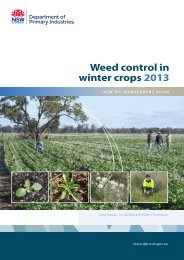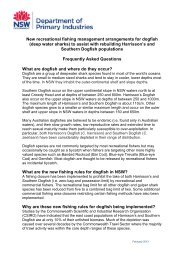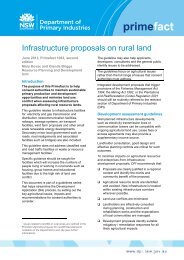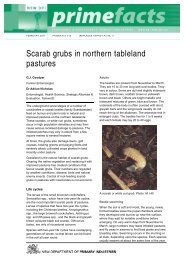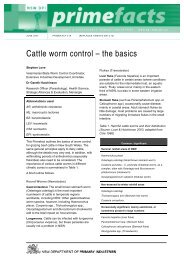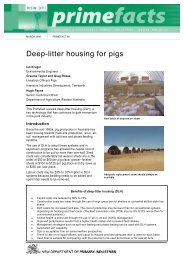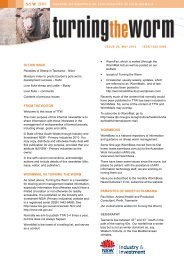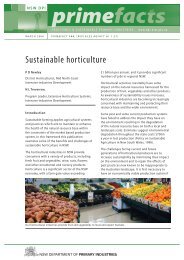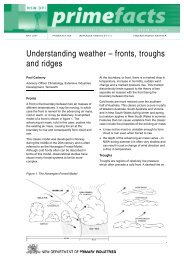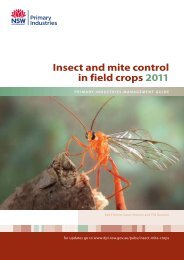Cheesy gland Caseous Lymphadenitis in sheep - NSW Department ...
Cheesy gland Caseous Lymphadenitis in sheep - NSW Department ...
Cheesy gland Caseous Lymphadenitis in sheep - NSW Department ...
You also want an ePaper? Increase the reach of your titles
YUMPU automatically turns print PDFs into web optimized ePapers that Google loves.
AGFACTS<br />
AGFACTS<br />
AGFACTS<br />
www.dpi.nsw.gov.au<br />
<strong>Cheesy</strong> <strong>gland</strong> or caseous lymphadenitis (CLA)<br />
<strong>in</strong> <strong>sheep</strong> is a bacterial disease of <strong>sheep</strong> caus<strong>in</strong>g<br />
abscesses <strong>in</strong> lymph nodes of the body and<br />
<strong>in</strong>ternal organs, especially the lungs. The ma<strong>in</strong><br />
cost of the disease to the <strong>sheep</strong> <strong>in</strong>dustry is<br />
through the loss of wool production that occurs <strong>in</strong><br />
affected <strong>sheep</strong> and losses through condemnation<br />
and trimm<strong>in</strong>g of carcases at abattoirs.<br />
An abattoir survey conducted by <strong>NSW</strong><br />
Agriculture <strong>in</strong> 1995 showed that 97% of flocks<br />
studied <strong>in</strong> <strong>NSW</strong> were <strong>in</strong>fected with cheesy<br />
<strong>gland</strong>. This is even worse than <strong>in</strong> other states.<br />
Similar surveys have found a cheesy <strong>gland</strong><br />
prevalence of 91% <strong>in</strong> Victoria, and 88% <strong>in</strong><br />
Western Australia. Most <strong>sheep</strong> producers do not<br />
realise that the disease is so common.<br />
CAUSE<br />
<strong>Cheesy</strong> <strong>gland</strong> is caused by the bacterium<br />
Corynebacterium pseudotuberculosis. The<br />
organism is usually filtered from the bloodstream<br />
by the lymph nodes, where it becomes trapped.<br />
A tox<strong>in</strong> is produced which destroys the lymph<br />
node tissue. Large abscesses then form.<br />
The pus with<strong>in</strong> these abscesses gradually dries<br />
out and becomes “cheesy” <strong>in</strong> appearance hence<br />
the common name cheesy <strong>gland</strong>.<br />
EFFECTS OF DISEASE<br />
Abscesses may form <strong>in</strong> any lymph node <strong>in</strong><br />
the body, but occur most commonly <strong>in</strong> the<br />
superficial lymph nodes of the shoulder and the<br />
flank. These may occasionally rupture, but are<br />
more often cut open at shear<strong>in</strong>g.<br />
<strong>Cheesy</strong> Gland<br />
<strong>Caseous</strong><br />
<strong>Lymphadenitis</strong><br />
<strong>in</strong> Sheep<br />
Agfact A3.9.21, 2nd edition 1996<br />
(Reviewed March 2005)<br />
Bel<strong>in</strong>da Walker, Veter<strong>in</strong>ary Officer,<br />
Division of Animal Industries<br />
Abscesses may also occur <strong>in</strong> the lungs, liver,<br />
spleen and kidneys. In <strong>sheep</strong> with <strong>in</strong>fected lungs<br />
abscesses may burst <strong>in</strong>to the air sacs. Infective<br />
material is then coughed up.<br />
While abscesses are form<strong>in</strong>g and the <strong>sheep</strong> are<br />
fight<strong>in</strong>g the <strong>in</strong>fection there is usually a fever,<br />
but this often goes unnoticed. Dur<strong>in</strong>g this<br />
period there is decreased wool production (see<br />
economic significance below).<br />
Severe chronic <strong>in</strong>fection may result <strong>in</strong> illthrift<br />
and emaciation <strong>in</strong> adult <strong>sheep</strong>, with subsequent<br />
poor reproductive performance. <strong>Cheesy</strong> <strong>gland</strong><br />
A carcase show<strong>in</strong>g an example of cheesy <strong>gland</strong>,<br />
detected dur<strong>in</strong>g <strong>in</strong>spection at the abattoir.<br />
ORDER NO. A3.9.21 AGDEX 430/653
This photo shows severely <strong>in</strong>fected lymph nodes between the lungs. A producer could be unaware of this<br />
<strong>in</strong>fection.<br />
can also occasionally cause mastitis <strong>in</strong> ewes, and<br />
has been suspected of caus<strong>in</strong>g uter<strong>in</strong>e <strong>in</strong>fections.<br />
Ram fertility can also be affected by abscesses<br />
form<strong>in</strong>g <strong>in</strong> or near the testes.<br />
ECONOMIC SIGNIFICANCE<br />
Research done <strong>in</strong> Western Australia has shown<br />
that an average of 0.2–0.25kg wool, or 4–7% of<br />
clean fleece weight is lost <strong>in</strong> the year of <strong>in</strong>fection.<br />
Because <strong>sheep</strong> are usually <strong>in</strong>fected at their first<br />
or second shear<strong>in</strong>g, this loss is <strong>in</strong>curred when the<br />
wool is at its f<strong>in</strong>est, and therefore most valuable.<br />
Further losses occur due to condemnation and<br />
trimm<strong>in</strong>g of carcases at abattoirs. Some 75% of<br />
a meat <strong>in</strong>spector’s time on the <strong>sheep</strong> cha<strong>in</strong> is<br />
Lymph nodes where <strong>Cheesy</strong> Gland commonly occurs<br />
– po<strong>in</strong>t of the shoulder (1) and <strong>in</strong> the flanks (2 and 3).<br />
2<br />
spent check<strong>in</strong>g for and remov<strong>in</strong>g cheesy <strong>gland</strong>.<br />
This adds considerably to kill<strong>in</strong>g costs.<br />
METHODS OF SPREAD<br />
The ma<strong>in</strong> method of spread is thought to be<br />
from <strong>sheep</strong> with <strong>in</strong>fected lungs. These <strong>sheep</strong><br />
cough onto fresh shear<strong>in</strong>g cuts on <strong>sheep</strong><br />
conf<strong>in</strong>ed with them after shear<strong>in</strong>g. Pus from<br />
abscesses cut open at shear<strong>in</strong>g is also a source<br />
of <strong>in</strong>fection.<br />
Protection from w<strong>in</strong>d and sunlight prolongs<br />
the survival of the bacteria. Research has<br />
demonstrated that hold<strong>in</strong>g the <strong>sheep</strong> under<br />
cover for an hour after shear<strong>in</strong>g almost doubles<br />
the risk of <strong>in</strong>fection.<br />
Dipp<strong>in</strong>g off shears, when the dip becomes<br />
contam<strong>in</strong>ated with pus, is also important <strong>in</strong> the<br />
spread of cheesy <strong>gland</strong>.<br />
Plunge or shower dipp<strong>in</strong>g <strong>in</strong>creases the chance<br />
of <strong>in</strong>fection 5–8 fold. Infection can occur even<br />
if no cuts are present. The bacteria are able to<br />
pass through <strong>in</strong>tact sk<strong>in</strong>, and <strong>in</strong>to the blood,<br />
even if <strong>sheep</strong> are dipped several months after<br />
shear<strong>in</strong>g. (Presumably <strong>in</strong> this situation, coughed<br />
up <strong>in</strong>fected material must be sufficient to<br />
contam<strong>in</strong>ate the dipp<strong>in</strong>g fluid.)<br />
Spread occurs via the bloodstream, and the<br />
lymphatic system.
The importance of dipp<strong>in</strong>g <strong>in</strong> the spread of<br />
<strong>in</strong>fection is shown by the comb<strong>in</strong>ed results<br />
of the surveys from three States. In flocks not<br />
treated at all for lice, the prevalence of cheesy<br />
<strong>gland</strong> was half that found <strong>in</strong> flocks where<br />
dipp<strong>in</strong>g was necessary. (Table 1.)<br />
Table 1. Prevalence of CLA associated with<br />
different lice control practices<br />
Lice Producers Average CLA<br />
control us<strong>in</strong>g this prevalence<br />
method method % for this<br />
method %<br />
None 6 14<br />
Plunge dip 37 29<br />
Shower dip 39 31<br />
Blackl<strong>in</strong>e 22 27<br />
An unexpected f<strong>in</strong>d<strong>in</strong>g was that CLA prevalence<br />
when backl<strong>in</strong>es were used was similar to that<br />
of other methods. This may relate to the fact<br />
that if backl<strong>in</strong>es are to be used, <strong>sheep</strong> are held<br />
together for longer after shear<strong>in</strong>g, allow<strong>in</strong>g more<br />
opportunity for the disease to be spread through<br />
cough<strong>in</strong>g.<br />
VACCINATION PROGRAM<br />
Vacc<strong>in</strong>ation aga<strong>in</strong>st cheesy <strong>gland</strong> is very effective.<br />
Survey data from three States show that a full<br />
vacc<strong>in</strong>ation program reduced the level of cheesy<br />
<strong>gland</strong> <strong>in</strong> their flocks to an average of 3 per cent<br />
(see Table 2). The average prevalence found<br />
over all flocks sampled <strong>in</strong> the surveys was 29<br />
per cent, with a range of 0–100 per cent.<br />
Table 2. The average CLA prevalence associated<br />
with us<strong>in</strong>g different CLA vacc<strong>in</strong>ation programs<br />
<strong>Cheesy</strong> <strong>gland</strong> Result<strong>in</strong>g<br />
vacc<strong>in</strong>ation <strong>in</strong>cidence of<br />
program used cheesy <strong>gland</strong> %<br />
Complete program<br />
2 shots plus annual boosters 3<br />
Incomplete program<br />
No vacc<strong>in</strong>ation 29<br />
1 shot as lamb, no booster 33<br />
1 shot as lamb plus booster 31<br />
2 shots as lamb, no booster 22<br />
The vacc<strong>in</strong>e used is comb<strong>in</strong>ed with 5-<strong>in</strong>-1<br />
vacc<strong>in</strong>ation aga<strong>in</strong>st clostridial disease. It is<br />
commonly known as 6-<strong>in</strong>-1.<br />
3<br />
Also available is a CLA vacc<strong>in</strong>e comb<strong>in</strong>ed with a<br />
pulpy kidney and tetanus 2-<strong>in</strong>-1 vacc<strong>in</strong>e. This is<br />
known as 3-<strong>in</strong>-1. The latter vacc<strong>in</strong>e may be used<br />
<strong>in</strong> areas where other clostridial diseases – black<br />
disease, blackleg, swelled head of rams, and<br />
malignant oedema – are not a problem.<br />
Because comb<strong>in</strong>ed vacc<strong>in</strong>ation is be<strong>in</strong>g<br />
performed <strong>in</strong> an effort to control more than<br />
one type of disease, there may be a conflict<br />
of <strong>in</strong>terest when it comes to tim<strong>in</strong>g booster<br />
<strong>in</strong>jections.<br />
• The best time to give a booster to a ewe<br />
to protect lambs from pulpy kidney (5-<strong>in</strong>-1<br />
component) is several weeks before lamb<strong>in</strong>g.<br />
• The best time to give a booster to protect the<br />
ewes from cheesy <strong>gland</strong> (6-<strong>in</strong>-1 component) is<br />
several weeks before shear<strong>in</strong>g.<br />
These dates do not often co<strong>in</strong>cide. In most<br />
enterprises, vacc<strong>in</strong>ation of ewes to protect<br />
lambs aga<strong>in</strong>st pulpy kidney is given the highest<br />
priority. Losses from pulpy kidney are more<br />
obvious and are seen to be the bigger problem.<br />
This may well be the correct approach on many<br />
properties, particularly where ewes are lamb<strong>in</strong>g<br />
on lush pastures.<br />
However, the hidden cost of cheesy <strong>gland</strong><br />
should not be forgotten. Shear<strong>in</strong>g is the time<br />
of greatest risk, so where possible the booster<br />
vacc<strong>in</strong>ation should be given at least three weeks<br />
before shear<strong>in</strong>g rather than at shear<strong>in</strong>g. Boosters<br />
Vacc<strong>in</strong>ate lambs under the loose sk<strong>in</strong> at the base of<br />
the ear.
at shear<strong>in</strong>g do not allow time for adequate<br />
immunity to develop and will not give full<br />
protection from cheesy <strong>gland</strong>.<br />
Even boosters given several months before<br />
shear<strong>in</strong>g will give better protection aga<strong>in</strong>st<br />
cheesy <strong>gland</strong> than boosters given at shear<strong>in</strong>g.<br />
This fact may allow for some compromise <strong>in</strong><br />
tim<strong>in</strong>g 6-<strong>in</strong>-1 vacc<strong>in</strong>ation, so that pulpy kidney<br />
protection and cheesy <strong>gland</strong> protection are both<br />
adequate.<br />
The most practical program for cheesy <strong>gland</strong><br />
would be for lambs to be vacc<strong>in</strong>ated at mark<strong>in</strong>g<br />
and aga<strong>in</strong> at wean<strong>in</strong>g, followed by an annual<br />
booster 4–6 weeks before shear<strong>in</strong>g.<br />
WARNING<br />
As with most vacc<strong>in</strong>ation programs it is critical that two<br />
doses of vacc<strong>in</strong>e are given close together to establish<br />
good immunity <strong>in</strong> the first place.<br />
Lambs must be vacc<strong>in</strong>ated twice before their first<br />
shear<strong>in</strong>g if protection is to be adequate.<br />
Depend<strong>in</strong>g on how much of a problem there is<br />
with pulpy kidney, and the tim<strong>in</strong>g of lamb<strong>in</strong>g<br />
and shear<strong>in</strong>g, it may be possible to give the<br />
annual booster at the summer drench, or at<br />
crutch<strong>in</strong>g.<br />
A s<strong>in</strong>gle dose of 6-<strong>in</strong>-1 at mark<strong>in</strong>g is useless<br />
as protection aga<strong>in</strong>st cheesy <strong>gland</strong>. This was<br />
the most common practice accord<strong>in</strong>g to our<br />
survey. After a couple of weeks lag time, a<br />
s<strong>in</strong>gle dose of vacc<strong>in</strong>e will give at best a few<br />
weeks protection aga<strong>in</strong>st clostridial disease. This<br />
practice is a waste of time and money <strong>in</strong> a wool<br />
production enterprise.<br />
The program adopted for your situation is best<br />
discussed with your veter<strong>in</strong>arian.<br />
4<br />
OTHER CONTROL MEASURES<br />
Other logical steps that should be taken to<br />
reduce spread of the disease, are:<br />
• Shear young <strong>sheep</strong> first.<br />
• Ensure good hygiene <strong>in</strong> the shear<strong>in</strong>g shed.<br />
• To reduce risk from close contact, release<br />
<strong>sheep</strong> from the yards as quickly as possible<br />
after shear<strong>in</strong>g and any other management<br />
practices (such as backl<strong>in</strong><strong>in</strong>g).<br />
• Avoid wet dipp<strong>in</strong>g off shears unless correctly<br />
vacc<strong>in</strong>ated, several weeks before shear<strong>in</strong>g.<br />
© The State of New South Wales 2005<br />
<strong>NSW</strong> <strong>Department</strong> of Primary Industries<br />
ISSN 0725–7759<br />
DISCLAIMER<br />
The <strong>in</strong>formation conta<strong>in</strong>ed <strong>in</strong> this publication is based<br />
on knowledge and understand<strong>in</strong>g at the time of writ<strong>in</strong>g<br />
(February 2005). However, because of advances <strong>in</strong><br />
knowledge, users are rem<strong>in</strong>ded of the need to ensure<br />
that <strong>in</strong>formation upon which they rely is up to date<br />
and to check currency of the <strong>in</strong>formation with the<br />
appropriate officer of the <strong>NSW</strong> <strong>Department</strong> of Primary<br />
Industries or the user’s <strong>in</strong>dependent adviser.<br />
ALWAYS READ THE LABEL<br />
Users of agricultural or veter<strong>in</strong>ary chemical products<br />
must always read the label and any permit, before us<strong>in</strong>g<br />
the product, and strictly comply with the directions on<br />
the label and the conditions of any permit. Users are<br />
not absolved from compliance with the directions on the<br />
label or the conditions of the permit by reason of any<br />
statement made or not made <strong>in</strong> this publication.<br />
5721




